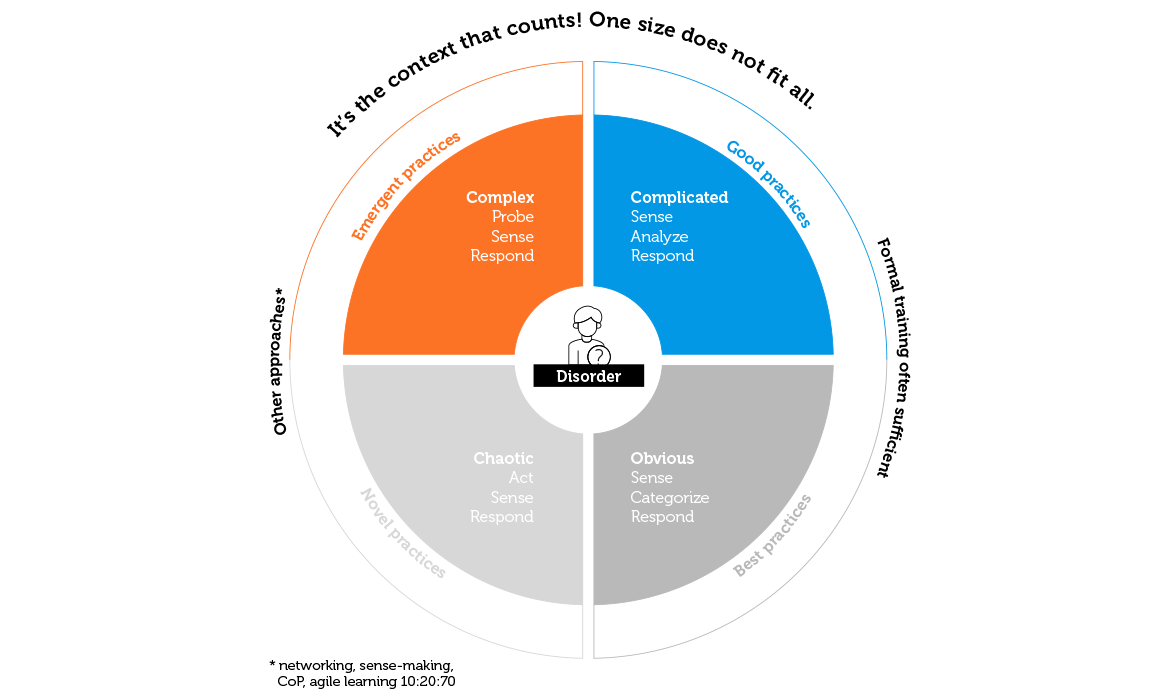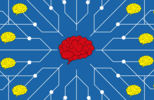Making better decisions using the Cynefin framework

In today’s VUCA world, we are increasingly faced with new, perplexing problems. The challenge is that tried-and-tested solutions can’t help us. In fact, they can even make matters worse. There is also a danger that we might oversimplify complex situations.
With this in mind, even well-established training offerings need to be carefully scrutinized. While formal learning methods may be the tool of choice in one situation, agile ways of learning may prove much more effective in helping attain the objective in another.
The Cynefin framework
To better assess situations and find the most effective solution for the task at hand, Dave Snowden, a Welsh researcher and consultant who worked at IBM for many years, developed the Cynefin framework. Pronounced “kuh-NEV-in”, the Welsh word for habitat, this model categorizes situations according to their complexity.
Besides an inner area of “disorder”, it distinguishes between four domains – obvious, complicated, complex and chaotic – each of which are assigned certain practices that are particularly promising.
The four domains
Obvious (also known as “simple”)
Obvious or simple systems are causal, with the relationship between cause and effect being easily discernible. There is, therefore, only one sensible way of tackling an obvious challenge – recognize (“sense”) the problem, categorize it and respond by following best practice.
In this domain, both well-known methods and formal approaches to teaching/learning generally lead straight to the target.
Let us look at an example of a broken light bulb. We recognize that it no longer lights up and there is only one sensible way of solving the problem – replace it.
Complicated
Complicated systems are also causal, but much more difficult to grasp. Recognizing the link between the cause and effect of a complicated problem requires expert knowledge and analysis. Even if there are good examples of similar projects that have been successful, decisions must be made on a case-by-case basis in every situation.
Once again, both conventional approaches and formal methods of teaching/learning are worth recommending here.
Let us look at the process of building a house as an example. By carefully analyzing soil conditions and materials and adopting a method that has already proven effective in other projects, the builders will ultimately ensure the construction project is a success.
Complex
Where it becomes much more difficult to maintain an overview is in complex situations. Here, correlations can only be identified after the fact. Such scenarios call for agile solutions. Rapid action, reflection and an unrelenting willingness to continuously adapt your approach to the situation as it evolves are all key to solving the problem. Collaborating with people who have different specialisms can offer a decisive advantage, too.
In this domain, we need to experiment, be open to errors and learn from mistakes. Ready-made solutions and formal teaching/learning arrangements don’t necessarily help us here, as the specific context has too great an influence. Instead, good communication and agile ways of learning empower us to take appropriate action – and comprehensive networking is absolutely crucial in this regard.
Let’s take Apollo 13 as an example. In this movie, astronauts are in real jeopardy. In order to save them, the staff in the control center have to come up with a solution using only the limited resources that are available to their colleagues up in space.
Chaotic
In chaotic systems, it is no longer possible to determine the relationship between cause and effect. In this domain, the top priority is to stabilize the critical situation. Seeing as such situations are usually unpredictable and highly specific, new solutions need to be developed by way of trial and error.
In this type of environment, the goal is to make intuitive decisions fast. Even though we are unable to specifically prepare for such one-off scenarios, a solid knowledge base, a good network and a creative approach all help quickly determine the best possible course of action when things go drastically wrong.
By way of example, imagine a building is on fire. The people inside do not have time to test out ideas or learn from mistakes. They follow their instinct and try to leave the building quickly and without much hesitation.
If we are unsure which of the four above domains we are facing, we are, according to Snowden, in a state of “disorder”. To make the right decisions, we should familiarize ourselves with the situation at hand and test whether a certain course of action actually helps solve the problem before we choose to pursue it. If it doesn’t, then the worst-case scenario is that the whole system breaks down – and a complex situation becomes a state of chaos.





